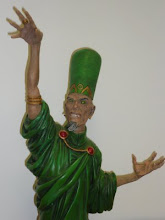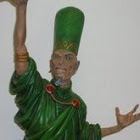
A very engaging and enjoyable anthology that executes a strong idea ,bibilical monsters in a modren context, with force and clarity.
"
Schoolyard Monster", written by Frank Martin, art by Adrian Crasmary, letters by Kel Nuttal. The set up for this story is simple, Joseph is being bullied at school and neglected by his parents. The relationship between Joseph and the bully, Rudy, is horribly plausible, Joseph is angry, frustrated and scared, Rudy has a nice line in self serving talk about helping Joseph. That the Golem arises from Joseph's frustrated helplessness is quietly made and the need that Rudy has for Joseph as a victim is well established. The Golem is a tool, a means to an end that Joseph desperately wants and cannot achieve by himself. Frank Martin can deliver a lot of information and context in a very small pace, the single panel of breakfast with Joseph and his parents captures Joseph's home life with cutting economy and great impact.
The art by Adrian Crasmary is a pleasure to read. The absence of sharp lines softens the look of the story and lets the very harsh intent of the story emerge in its own time. The expressive body language and faces of the cast are in marked contrast to the blankness of the Golem. The contrast between Joseph and Rudy is never overdone, there is just enough of a difference in height to make it clear that malice as much as strength is what Rudy uses to dominate Joseph. The muted colours capture the details of the physical context and shade the faces very effectively. Best of all the Golem never dominates the story with his presence, he is part of the context never overshadowing the real action.
"
The Great Hunt" written by Frank Martin, art by Igor Chakal, colours by Stanislaus Leonov. A couple arrive on game reserve looking to hunt a creature that apparently has killed other hunters. Naturally they ignore the warnings from the warden and head out on their way to capture their prey. It does not end well. Frank Martin includes some details to give the considerably more weight and impact. The reason the couple are hunting the creature is simple and strong and the final pay off effective.The set up seems to deliver stock characters in a well worn situation, the motivation for the trip pulls them directly to life just in time to encounter the Behemoth.
Igor Chakal's art captures the feel of old films about reckless white big game hunters who were lead by arrogance out of their depth in the bush. This is exactly what the straight lines of the story needs, the momentum that leads to the confrontation. When it arrives it is delivered with great force and impact. The details are every bit as bloody and brutal as they need to be. Stanislaus Leonov's colours are a bright and bold as the reserve should be, when the switch comes to night time, the lighting is not dimmed to hide the action. Stanislaus Leonov manages something difficult, the nighttime is important, still the details of the attack have to be vivid and the sequence works without feeling absurd on either count.
"
What Is He Good For? (Absolutely Nothing)" written by Frank Martin, art by Noreus Teves, colours by Laura Ruggeri. This is the most substantial story of the three due to the fact that Frak Marshall has solved a very considerable problem and made it look easy. In any story if a member of the cast is one of The Four Horsemen of the Apocalypse the story is very likely to buckle under the weight of this character. They are such forceful concepts that trying to fit them into a human context without them destroying any dramatic tension is a very significant story problem. Frank Martin does exactly that and then uses the character is dramatically satisfying way.
Noreus Teves's art creates the necessary physical context for the story, it has to have a very strong sense of place to support the huge weight of the Horseman, the details have to very strong to allow the human cast a chance. The swagger and well founded confidence exuded by the Horseman is powerfully displayed and contrasted with the fear and uncertainty of the human cast.
The bright colours used by Laura Ruggeri capture the sunshine of the cruise, the darkness is all in the unfolding events. The vivid colours of the Horseman's outfit is a smart contrast to his usual outfits and provides very effective camouflage.
Kel Nuttal's letters are quietly unobtrusive and natural, they are easy to read and never draw attention away from the art or the story.The tremendous sound effects on the other hand are a out loud joy, they add depth to and weight to the action.
This is a very impressive comic, Frank Martin has something to say and does so without ever unbalancing the stories, the artists bring all the nuances of the stories to the fore without crowding or forcing the reader.
Chief Wizard Note: This is a review copy very kindly sent by Frank Martin. Modern Testament Tales of the Ethereal. Vol 2. will be available from
insanecomics.com from Monday 20th June 2016. You should get a copy, reading good comics has been proven to deliver elevated levels of happiness an satisfaction with living.
 A very enjoyable collection of classic fairy tales set in a science fiction, specifically Doctor Who, context.
A very enjoyable collection of classic fairy tales set in a science fiction, specifically Doctor Who, context.



